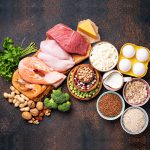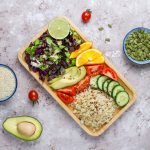We know how difficult and tiresome a weight loss journey can sound, but it need…
Read MoreAll of us think about losing a couple of pounds now and then, especially when our clothes stop fitting us. But maintaining a healthy weight is not just about appearances. It is critical for our health. It may help ward off diseases like diabetes, heart disease, arthritis, and even some cancers. And it can help keep your blood pressure, blood sugar, and cholesterol levels under control.[1][Weight Control].U.S. National Library of Medicine. We’ve got you covered, if you’re looking for ideas to lose weight naturally.
Obesity has been described as ‘sthaulya’ or ‘medoroga’ in ayurvedic texts. According to ayurveda, it is a condition in which ‘medo dhatu’ (fatty tissue) is in a state of vikrita vriddhi (abnormal increase). Besides your diet, Ayurveda also implicates heredity (bijadosha), and psychological factors in the causation of obesity.
According to ayurveda, three forces – pitta, vata, and kapha – composed of elemental aspects such as fire, water, earth, and space govern all biological processes. When these three forces or doshas are in a harmonious state you’re healthy. Any imbalance, on the other hand, leads to disease and causes problems like obesity. Therefore, obesity is treated by bringing the doshas back into balance. Aggravation of kapha dosha is thought to be generally responsible for obesity. This aggravation is considered to cause fat accumulation and water retention. Various strategies may be recommended by ayurveda for weight loss:
Ayurveda also considers the constitution of an individual to be an important factor in addressing obesity. Dietary interventions are based on an individual’s constitution or their predominant dosha.
1. Vata: This dosha is composed of air and space. And it is considered to have the quickness and mobility of these two elements. For those with vata composition, a diet consisting mostly of potato, wheat, rice, gram flour, fish, and black gram can be helpful.
2. Pitta: This dosha is associated with the element of fire. For those with a pitta constitution, a diet consisting mostly of gram flour, barley, dairy (paneer), amla, rice, green gram, soya, and animal foods such as eggs or chicken can be helpful.
3. Kapha: This dosha is composed of earth and water and is associated with the stability and solidity of these elements. For those with a kapha form, a diet consisting mostly of barley, wheat bran, soy nuggets, green gram, garlic, and gram flour can be helpful.
One study found that an intervention based on the above diet resulted in significant weight loss in people of all three constitutions over a period of time.[2]Sharma, Shikha, Seema Puri, Taru Agarwal, and Vinita Sharma. “Diets based on Ayurvedic constitution–potential for weight management.” Alternative Therapies in Health & Medicine … Continue reading
Taking in fewer calories than you burn is the simple equation that leads to weight loss. However, do keep in mind that it is safer to lose weight at the rate of ½ kg to 1 kg per week, rather than cutting calories drastically. This means that typically:
Another important factor to consider when you cut calories is that you’re opting for a healthy diet that gives you all the nutrients that you need. So what should a healthy diet contain? Here are a few pointers:
One way to reduce your calorie intake while still having a balanced diet is by controlling the portion size. Here are a few tips to help you do that:
Research shows that having proteins, dairy and vegetables can help you lose weight. Let’s take a look at how they help.
Research shows that having at least 3 servings of dairy products daily can significantly reduce body fat mass in obese people. It also speeds up body fat loss and weight loss when compared to people on low dairy diets. Calcium present in dairy foods appears to play a role here. It appears to reduce weight gain and the accumulation of body fat when you overeat. It also increases the breakdown of fat and preserves metabolism when you’re on a calorie restricted diet.[12]Zemel, Michael B. “The role of dairy foods in weight management.” Journal of the American College of Nutrition 24, no. sup6 (2005): 537S-546S.In fact, one study that looked at the impact of consuming yogurt on people who were on a calorie restricted diet found it to be extremely beneficial. Those who had yogurt lost 81% more than the group which didn’t.[13]Zemel, M. B., J. Richards, S. Mathis, A. Milstead, L. Gebhardt, and E. Silva. “Dairy augmentation of total and central fat loss in obese subjects.” International journal of obesity 29, … Continue reading
Water is the best drink for avoiding dehydration if you’re looking to lose weight. That’s because it has zero calories. Other drinks like milk or buttermilk are also good choices since they offer many nutrients even though they contain calories. However, it’s best to avoid drinks that contain a lot of added sugar such as soft drinks, flavoured milks, coffee with cream and syrup etc. They tend to contain a lot of added sugar and are nutritionally poor.[17][Weight loss – common myths]. Better Health Channel.According to Ayurveda, sugar is madhur (sweet) and guru (heavy). And that is the exact opposite of what you should be consuming if you want to lose weight.
Some foods like eggs, turmeric, and pepper have the capacity to boost weight loss:
Triphala churna is a medicinal powder made up of three fruits bibhitaki (T bellirica), haritaki (T chebula), and amalaki (E officinalis). The rasa or taste of Triphala is sweet, sour, pungent, bitter, and astringent; the only taste not contained within the formula is salty. It is considered to balance all three doshas. It has been traditionally used by ayurvedic physicians to promote satiety and digestion. And it can be helpful in tackling obesity. One animal study found that mice who were fed a high fat diet experienced a significant reduction in body weight and percentage of body fat when they were also given triphala churna. Additionally, their cholesterol levels also improved. Your ayurvedic doctor can prescribe the appropriate dosage for you if you’re looking to use this ancient medicinal formulation as an aid on your weight loss journey.[22]Gurjar, Shaifali, Anuradha Pal, and Suman Kapur. “Triphala and Its Constituents Ameliorate Visceral Adiposit y From a High-fat Diet in Mice With Diet-induced Obesity.” Alternative … Continue reading
Many of us tend to munch on something while we’re watching television, driving, or even working. Because we’re not paying attention, we’re not completely aware of what or how much we’re eating. This sort of mindless eating could pile on the pounds. That’s why the ancient science of ayurveda advocates mindful eating. According to it, eating mindfully enhances digestion by focusing all your attention on one single body process.
Plain old water can help you lose weight. According to a study people on a low calorie diet lost more weight when they drank 500ml of water before eating. How does that happen? It’s probably because they filled up on water and this led to them having a smaller meal.[24]Dennis, Elizabeth A., Ana Laura Dengo, Dana L. Comber, Kyle D. Flack, Jyoti Savla, Kevin P. Davy, and Brenda M. Davy. “Water consumption increases weight loss during a hypocaloric diet … Continue readingIt’s also worth noting that research has found that drinking 500ml of water increases energy expenditure by 24% over the course of the next hour.[25]Boschmann, Michael, Jochen Steiniger, Gabriele Franke, Andreas L. Birkenfeld, Friedrich C. Luft, and Jens Jordan. “Water drinking induces thermogenesis through osmosensitive mechanisms.” … Continue reading So make sure you’re drinking enough water. And make sure you don’t mistake thirst for hunger and reach for a calorie- dense snack instead of calorie free water, as people often do.[26][Hunger vs. thirst: Are you eating when you should be drinking?]. The Seattle Times.
Intermittent fasting aims to reduce calorie intake by alternating fasting and non-fasting periods. It mainly comes in 3 avatars:
Intermittent fasting can not only help you lose weight, it can reduce body fat and help control blood sugar levels too.[27][How Good a Diet Is Intermittent Fasting?]). Scientific American.2020. Laghana chikista (fasting therapy) is also considered an important step in weight management.
Research suggests that not getting enough sleep is linked to being overweight. One study found that overweight women who reported better sleep quality had a 33% higher chance of successfully losing weight. Sleeping more than 7 hours a night was also found to improve the likelihood of successful weight loss. That’s because the amount of sleep you get can impact your hormones. Inadequate sleep has been found to reduce leptin – a hormone that promotes satiety – and increase ghrelin – a hormone that promotes hunger.[29]Thomson, Cynthia A., Kelly L. Morrow, Shirley W. Flatt, Betsy C. Wertheim, Michelle M. Perfect, Jennifer J. Ravia, Nancy E. Sherwood, Njeri Karanja, and Cheryl L. Rock. “Relationship between … Continue reading
Properties of the diet should be opposite of properties of vata like snigdha (unctuous), guru (heavy), ushna (warm), etc.
Example: Person of vata prakriti can take regular foods like cereals such as rice, wheat; pulses like black gram, horse gram. Fruits like, gooseberry, grapes, banana, dates, apple, pineapple, pomegranate. Spices like asafoetida, clove, cardamom, cinnamon, pepper, cumin, garlic, coriander. Dairy products like milk, ghee, curd, buttermilk, butter. Oils like sesame oil, mustard oil, coconut oil. Meat of cow, goat, buffalo, etc.
Note: Vata dosha is aggravated and increased during varsha (rainy season), autumn and early winter. During these seasons all mind-body types can include some of the above foods and decrease others. Mental and emotional peace and constructive daily life routines are vital to restoring and maintaining stability.
Properties of the diet should be opposite of pitta guna, like as ruksha (not unctuous), sheeta (Ccold), food with moderately heavy texture etc
Example: Person of pitta prakriti can take regular food like cereals such as rice, wheat, barley, millet; pulses like green gram, bengal gram, ghee, butter, fresh curd, milk; vegetables such as snake gourd, bitter gourd brinjal, cabbage, spinach; fruits such as gooseberry, grapes, apple, dates pomegranate, banana; spices such as coriander, turmeric; meat of deer, goat, buffalo and rabbit are beneficial. Oils like sesame oil, coconut oil and sunflower oil.
Note: Pitta dosha is aggravated and increased during summer, hot, dry seasons. During these seasons all mind-body types can include some of the above foods and decrease others. Mental and emotional peace and constructive lifestyle routines are important to restoring and maintaining balance.
Properties of the diet should be opposite of Kapha guna, like as laghu (light), ushna (hot and worm food), Dry etc
Example: Person of kapha prakriti should take regularly cereals and grains like rice, barley, corn, millet; pulses like bengal gram, horse gram, greengram; vegetables like brinjal, radish, snake gourd, bitter gourd, cabbage; spices like asafoetida, black pepper, cloves, coriander, cumin, turmeric, cardamom; fruits gooseberry, grapes, pomegranate, papaya, lemon; dairy products like buttermilk; meat of goat, rabbit, deer; oils like sesame oil, mustard oil.
Note: Kapha dosha is aggravated and increased in the spring season. During this season you should consume less food and select drier, fibrous foods during the cold season.
Individuals having a constitution dominated by a combination of two or three doshas should follow the diet of combination of the respective doshas.
References
| ↑1 | [Weight Control].U.S. National Library of Medicine. |
|---|---|
| ↑2 | Sharma, Shikha, Seema Puri, Taru Agarwal, and Vinita Sharma. “Diets based on Ayurvedic constitution–potential for weight management.” Alternative Therapies in Health & Medicine 15, no. 1 (2009): 44. |
| ↑3, ↑5 | [Start the NHS weight loss plan]. NHS. |
| ↑4 | [Healthy Eating for a Healthy Weight](https://www.cdc.gov/healthyweight/healthy_eating/index.html “Healthy Eating for a Healthy Weight”). Centers for Disease Control and Prevention. |
| ↑6 | [Very low calorie diets]. NHS. |
| ↑7 | [Portion size]. U.S. National Library of Medicine. |
| ↑8 | Leidy, Heather J., Peter M. Clifton, Arne Astrup, Thomas P. Wycherley, Margriet S. Westerterp-Plantenga, Natalie D. Luscombe-Marsh, Stephen C. Woods, and Richard D. Mattes. “The role of protein in weight loss and maintenance.” The American journal of clinical nutrition 101, no. 6 (2015): 1320S-1329S. |
| ↑9, ↑11 | [When it comes to protein, how much is too much?]. Harvard Medical School. |
| ↑10 | [Protein in diet]. U.S. National Library of Medicine. |
| ↑12 | Zemel, Michael B. “The role of dairy foods in weight management.” Journal of the American College of Nutrition 24, no. sup6 (2005): 537S-546S. |
| ↑13 | Zemel, M. B., J. Richards, S. Mathis, A. Milstead, L. Gebhardt, and E. Silva. “Dairy augmentation of total and central fat loss in obese subjects.” International journal of obesity 29, no. 4 (2005): 391-397. |
| ↑14 | Nour, Monica, Sarah Alice Lutze, Amanda Grech, and Margaret Allman-Farinelli. “The relationship between vegetable intake and weight outcomes: a systematic review of cohort studies.” Nutrients 10, no. 11 (2018): 1626. |
| ↑15 | [Weight loss and carbohydrates]. Better Health Channel. |
| ↑16 | [Getting enough protein]. Better Health Channel. |
| ↑17 | [Weight loss – common myths]. Better Health Channel. |
| ↑18 | Vander Wal, J. S., Alok Gupta, Pramod Khosla, and N. V. Dhurandhar. “Egg breakfast enhances weight loss.” International Journal of obesity 32, no. 10 (2008): 1545-1551. |
| ↑19 | Ranade, Anagha, and Rabinarayan Acharya. “AYURVEDIC MANAGEMENT OF AARTAVA KSHAYA WSR POLYCYSTIC OVARIAN SYNDROME–A CRITICAL REVIEW.” |
| ↑20 | Shah, Shreya S., Gaurang B. Shah, Satbeer D. Singh, Priyanshi V. Gohil, Kajal Chauhan, Khyati A. Shah, and Mehul Chorawala. “Effect of piperine in the regulation of obesity-induced dyslipidemia in high-fat diet rats.” Indian journal of pharmacology 43, no. 3 (2011): 296. |
| ↑21 | Akbari, Maryam, Kamran B. Lankarani, Reza Tabrizi, Majid Ghayour-Mobarhan, Payam Peymani, Gordon Ferns, Amir Ghaderi, and Zatollah Asemi. “The effects of curcumin on weight loss among patients with metabolic syndrome and related disorders: a systematic review and meta-analysis of randomized controlled trials.” Frontiers in pharmacology 10 (2019): 649. |
| ↑22 | Gurjar, Shaifali, Anuradha Pal, and Suman Kapur. “Triphala and Its Constituents Ameliorate Visceral Adiposit y From a High-fat Diet in Mice With Diet-induced Obesity.” Alternative Therapies in Health & Medicine 18, no. 6 (2012). |
| ↑23 | [8 steps to mindful eating].Harvard Medical School.2016. |
| ↑24 | Dennis, Elizabeth A., Ana Laura Dengo, Dana L. Comber, Kyle D. Flack, Jyoti Savla, Kevin P. Davy, and Brenda M. Davy. “Water consumption increases weight loss during a hypocaloric diet intervention in middle‐aged and older adults.” Obesity 18, no. 2 (2010): 300-307. |
| ↑25 | Boschmann, Michael, Jochen Steiniger, Gabriele Franke, Andreas L. Birkenfeld, Friedrich C. Luft, and Jens Jordan. “Water drinking induces thermogenesis through osmosensitive mechanisms.” The Journal of Clinical Endocrinology & Metabolism 92, no. 8 (2007): 3334-3337. |
| ↑26 | [Hunger vs. thirst: Are you eating when you should be drinking?]. The Seattle Times. |
| ↑27 | [How Good a Diet Is Intermittent Fasting?]). Scientific American.2020. |
| ↑28 | [5 questions about intermittent fasting]. National Library of Medicine. |
| ↑29 | Thomson, Cynthia A., Kelly L. Morrow, Shirley W. Flatt, Betsy C. Wertheim, Michelle M. Perfect, Jennifer J. Ravia, Nancy E. Sherwood, Njeri Karanja, and Cheryl L. Rock. “Relationship between sleep quality and quantity and weight loss in women participating in a weight‐loss intervention trial.” Obesity 20, no. 7 (2012): 1419-1425. |


Dr. Aswathy has 10+ years of experience as an Ayurvedic consultant and medical officer in different nursing homes and hospitals. She has a deep knowledge of classical texts, Ayurvedic treatments, and Panchkarma. Dr. Aswathy is proficient in diagnosis through traditional Ayurvedic means and plans treatment that is specific to an individual’s constitution.

We know how difficult and tiresome a weight loss journey can sound, but it need…
Read More
The key to healthy weight loss is achieving a negative energy balance or taking in…
Read More
Thanks for choosing Kapiva! Ayurveda is about balance, the same translates to its view on…
Read More
Welcome! We are truly thrilled to have you on board with us on Kapiva's personalised…
Read More